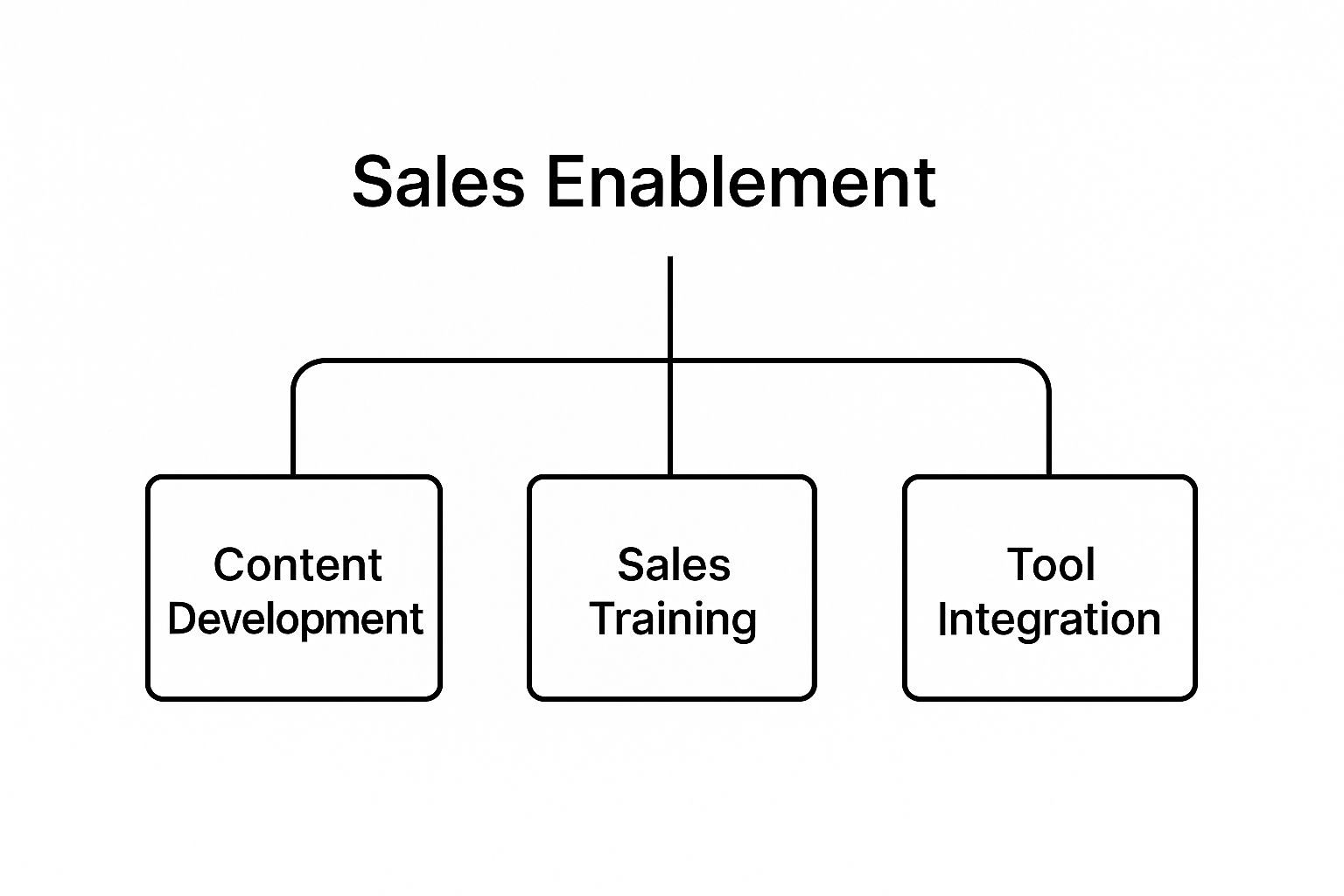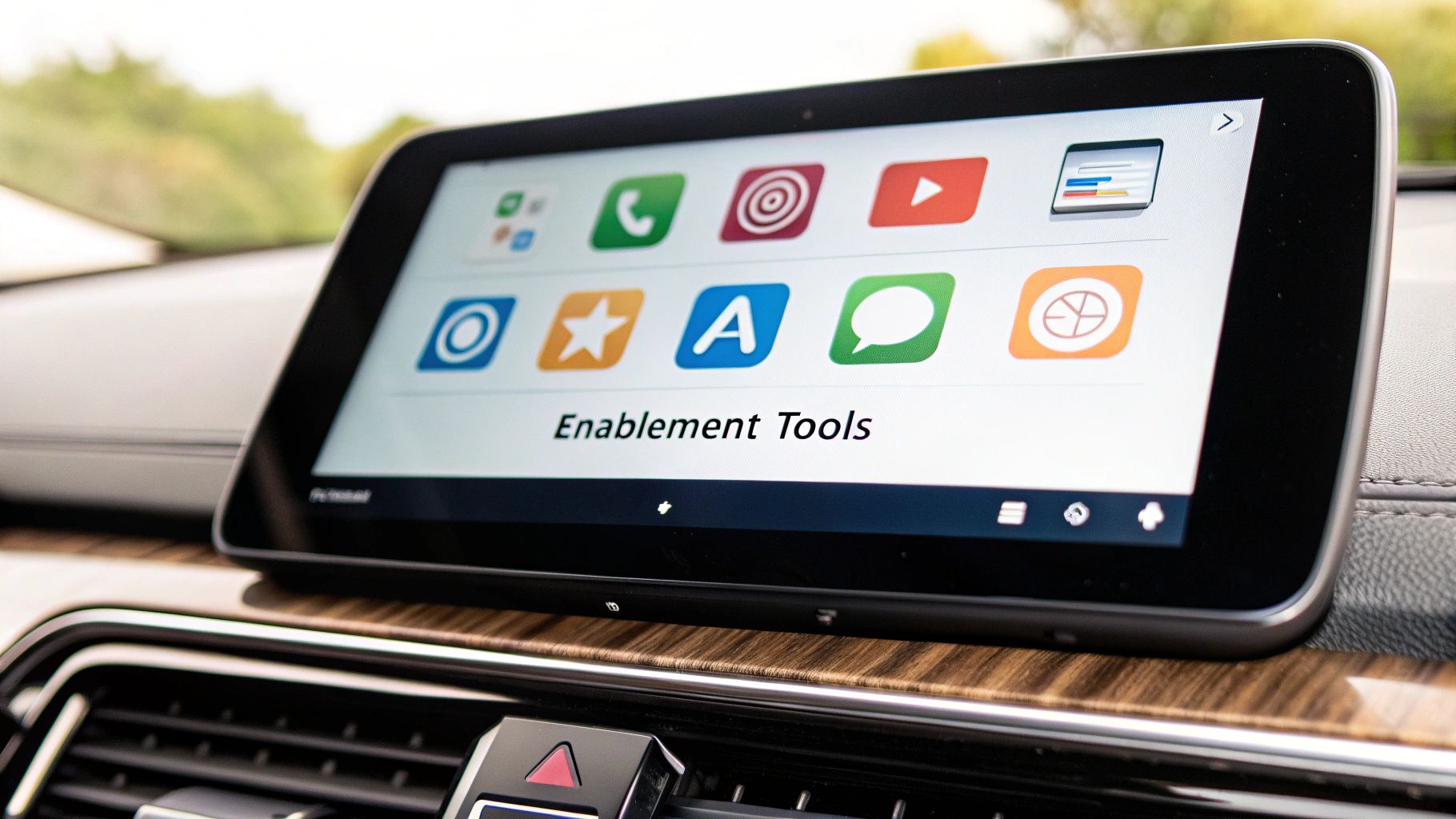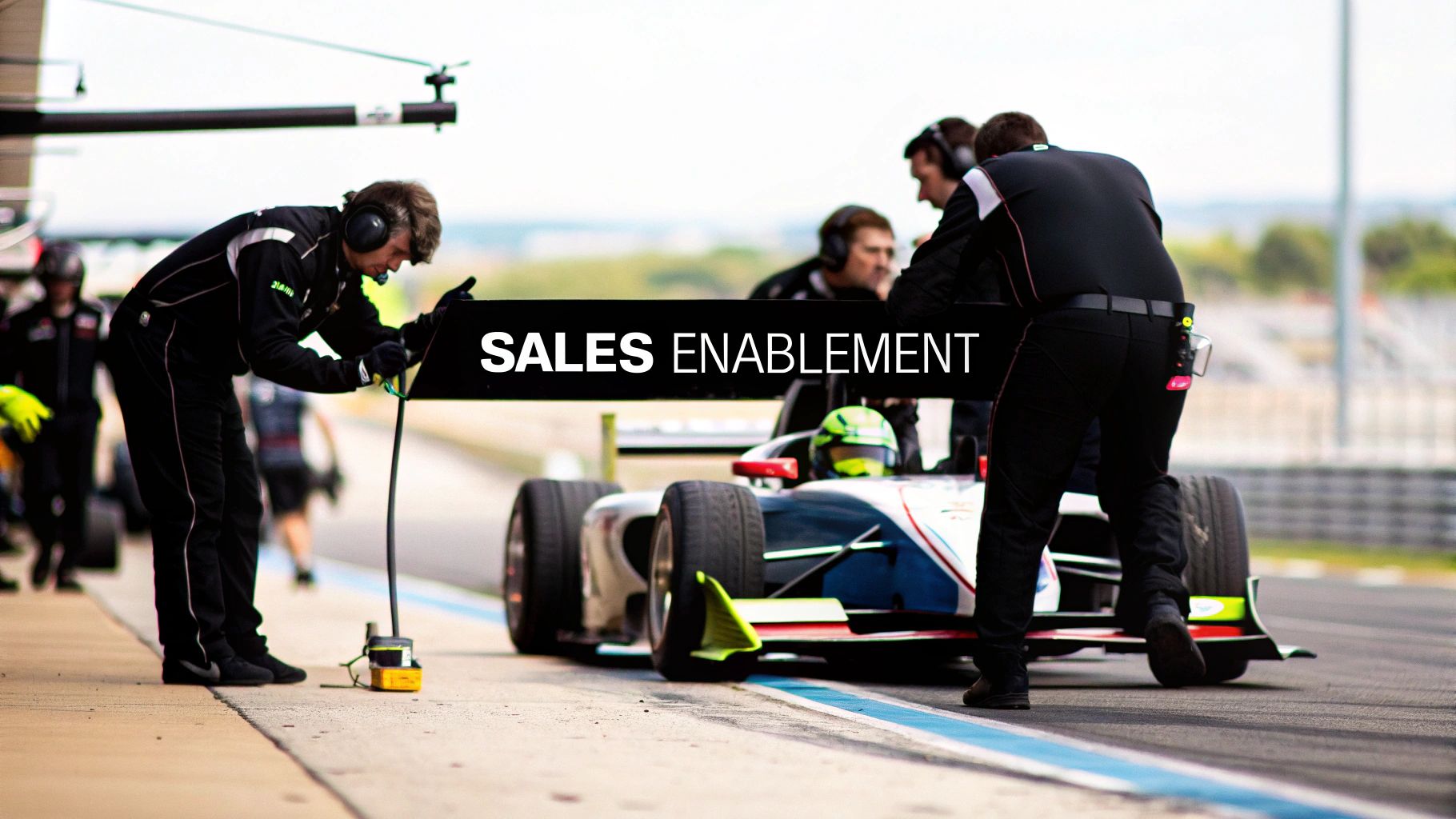Sales enablement is really just the strategic process of giving your sales team everything they need to close more deals. It’s all about providing your reps with the best content, training, and technology at the exact right moment to connect with buyers and shorten the whole sales cycle.
What Is Sales Enablement Really

Let's cut through the buzzwords for a second.
Think of your best field sales rep as a Formula 1 driver. Sales enablement is their entire pit crew. The crew isn't driving the car, but they're the ones providing the perfectly tuned engine, giving real-time data on track conditions, and mapping out a winning race strategy. All of this frees up the driver to focus on one thing: performance and crossing that finish line first.
In the same way, sales enablement equips your team—especially those out in the field and doing D2D sales—with precisely what they need to nail every single customer interaction. It's a formal process that aligns your people, processes, and technology to get better sales results, plain and simple.
Moving Beyond Random Acts of Sales Support
Lots of organizations think they're doing enablement, but what they really have are disconnected efforts. Marketing creates a brochure over here, a manager offers some occasional coaching over there, and IT provides a basic CRM. While everyone means well, these are just random acts of support.
True sales enablement is about organizing all those activities into one cohesive, repeatable system that actually works.
This strategic approach makes sure every resource and every piece of training is built with a purpose: helping reps overcome specific challenges and move deals forward.
The results of a structured approach speak for themselves. Recent survey data shows 76% of executives believe that investing in sales enablement programs has directly boosted their sales results. On top of that, 65% of companies that beat their revenue targets had a dedicated sales enablement function in place. You can learn more about these compelling sales enablement statistics and see the impact for yourself.
A modern sales enablement strategy is built on a few key pillars. Each one addresses a critical need for your sales team, from the content they share to the skills they develop.
The Pillars Of A Modern Sales Enablement Strategy
table block not supported
By weaving these four pillars together, you create a powerful support system that doesn't just help your reps—it empowers them to perform at their absolute best.
The Foundational Goal Driving Growth
When you get right down to it, the purpose of sales enablement is to make every single seller more effective. It achieves this by zeroing in on three main objectives:
- Boosting Sales Efficiency: It slashes the time reps waste searching for content or getting bogged down in administrative tasks, freeing them up to do what they do best—sell.
- Improving Seller Effectiveness: It provides continuous training and coaching to build the skills and confidence they need to navigate any buyer conversation.
- Driving Revenue: By making reps more efficient and effective, enablement directly leads to shorter sales cycles, higher win rates, and predictable, sustainable growth.
For field and D2D sales teams using a platform like LeadFlow Manager, this is a game-changer. Enablement ensures every rep has instant mobile access to vital info—from updated product specs to competitor battle cards—right when they're at a customer's doorstep. This transforms them from just another salesperson into a trusted advisor, ready to add real value at every turn.
The Core Components Of A Winning Strategy
Knowing what sales enablement is is one thing, but understanding its moving parts is where the real magic happens. A winning strategy isn’t a single, one-off project. It's more like a powerful engine built from several interconnected components. When they all fire in sync, they create a system that helps every single sales rep perform at their absolute best.
Think of it like building a high-performance vehicle for your sales team. You wouldn’t just obsess over the engine and forget about the wheels or the navigation system, right? Every part needs to be carefully selected and perfectly integrated to make sure the journey to closing the deal is smooth, fast, and successful.
This infographic lays out the core pillars that hold up a truly comprehensive sales enablement strategy.

As you can see, content, training, and technology are the foundational pieces supporting every sales activity. Let's dig into what each of these looks like in practice.
Strategic Content And Resources
It's almost unbelievable how much time sales reps can waste just hunting for the right content to send a prospect. Some reports suggest it's as much as 440 hours per year. That's a massive productivity killer. Strategic content enablement is all about getting rid of that friction. The goal is to build a central, easy-to-search library of materials that answer specific buyer questions at every stage of their journey.
For field teams, this means having resources designed for face-to-face interactions, such as:
- Case Studies and Testimonials: Nothing builds trust at the doorstep like real-world social proof.
- Competitor Battle Cards: These are quick-reference guides that help reps handle objections and clearly position your unique value.
- One-Pagers and Product Specs: Think concise, mobile-friendly documents that are perfect for sharing during a live conversation.
This is where a platform like LeadFlow Manager becomes invaluable. It acts as that central hub, putting the perfect piece of content right at a rep's fingertips the moment they need it.
Continuous Training And Coaching
The days of a single onboarding session are long gone. Truly effective sales enablement requires a deep commitment to continuous learning and development. And we're not just talking about product knowledge here. It's about constantly sharpening core selling skills, practicing how to handle tough objections, and building the kind of confidence that customers can feel.
Modern training is often bite-sized and ongoing, frequently delivered through technology. For D2D teams, this could be as simple as watching a quick video on a new sales script before heading out for the day or role-playing a tricky scenario with their manager through a coaching app. This approach ensures learning is reinforced and can be applied in the field immediately.
The Right Technology And Tools
Technology is the backbone that holds this entire strategy together. The right tools can automate tedious admin tasks, simplify workflows, and give reps the data they need to have smarter, more relevant conversations. For any field team, a robust CRM designed for mobile use—like LeadFlow Manager—is absolutely non-negotiable.
This kind of integration is also a crucial part of effective sales operations planning, making sure every tool has a clear purpose in driving the team's efficiency.
Actionable Performance Analytics
Finally, a winning strategy is a data-driven one. Sales enablement isn't based on gut feelings or guesswork; it’s about measuring what's working and fine-tuning what isn't. By tracking key metrics—like which content gets used most, individual rep activity levels, and conversion rates—managers get a crystal-clear picture of performance.
This data tells a story. It can show you which sales materials are resonating with customers, identify where reps might need a bit more support, and pinpoint which coaching efforts are delivering the best return. With these analytics, you can continuously refine your approach, ensuring your sales enablement strategy gets better and smarter over time.
Why Sales Enablement Is More Important Than Ever

Not too long ago, sales enablement was often treated as a background support function—a "nice-to-have" but not a must-have. That time is long gone. Today, it’s a core part of any successful business strategy, and for good reason.
The shift happened because the customer completely changed the game. Modern buyers are more informed and self-sufficient than ever. They've already done their homework online, formed opinions, and come to the conversation expecting real, immediate value. This has made every sales interaction a high-stakes moment, and a scattered, informal approach just won't cut it anymore.
To win in this environment, sales teams need a structured, strategic framework that ensures they are always prepared, confident, and perfectly on-message.
The Move From Scattered Support To Strategic Function
Smart businesses are catching on. They’re ditching the old, random acts of support and building mature, integrated sales enablement programs to get a real competitive edge. This means investing seriously in both people and technology to create a system that’s built for seller success from the ground up.
The numbers back this up. The sales enablement platform market is expected to grow at a compound annual growth rate (CAGR) of 15.2% through 2030. Tech platforms are the biggest piece of that puzzle, making up over 75% of the market's revenue. This huge investment makes it clear: a formal enablement strategy isn't optional anymore.
You can dig deeper into these trends in this comprehensive sales enablement platform market report from Grand View Research.
This strategic shift does wonders for team morale, too. When your reps feel genuinely supported and have the right tools to win, their motivation and performance shoot through the roof. If you're looking for ways to fire up your own team, our guide on how to motivate a sales team is packed with proven strategies.
At the end of the day, sales enablement has become essential because the alternative—leaving your reps to figure things out alone—is a guaranteed way to get inconsistent results, miss opportunities, and fall behind the competition.
How Technology Powers Modern Sales Teams
If your sales enablement strategy is the blueprint, then technology is the high-performance engine that actually brings it to life. For any modern sales team—especially those out in the field—the right tech stack isn't just a nice-to-have. It’s the central nervous system connecting every part of the process. It’s what turns theory into tangible, daily action.
Think about it this way: a brilliant sales playbook is completely useless if it's collecting dust in a binder back at the office. Technology puts that playbook, and every other critical resource, right into your reps' hands the moment they need it. This simple shift ensures they can deliver the right message at the right time, turning a simple customer interaction into a genuine opportunity.
Integrating The Modern Sales Tech Stack
The best sales enablement platforms don't operate in a silo. They act as a central hub, tying together your customer relationship management (CRM), content libraries, and communication tools into one seamless system. This integration gets rid of the friction that bogs reps down, like constantly switching between apps or digging for outdated information.
For D2D and field sales teams, this is make-or-break. An integrated platform like LeadFlow Manager gives everyone a single source of truth, combining:
- CRM Functionalities: To manage leads, track every interaction, and view the entire customer journey from a phone or tablet.
- Content Management: Giving reps instant access to the latest battle cards, case studies, and pricing sheets right before a meeting.
- Real-Time Analytics: Letting managers see what’s actually working in the field and pinpoint exactly where coaching is needed.
This kind of technological backbone is what turns a well-thought-out plan into a results-driven reality, day in and day out.
The Rise Of AI In Sales Enablement
The story of sales enablement is really a story about adopting powerful new technologies. One of the most significant game-changers today is the use of advanced Lead Generation AI to supercharge the sales funnel. Artificial intelligence is giving reps predictive insights that help them identify the most promising opportunities, so they can focus their energy where it will count the most.
And this isn't just a fleeting trend. Projections show that a whopping 54% of businesses expect to integrate even more AI into their sales processes very soon. While some companies still grapple with data integration challenges, the move toward AI-driven enablement is undeniable. It marks a fundamental shift in how sales teams are going to operate. By automating routine tasks and serving up data-backed recommendations, technology is finally freeing up salespeople to do what they do best: build relationships and close deals.
Getting Your Sales Enablement Program Off The Ground
Knowing the theory behind sales enablement is one thing, but actually putting it into practice is where the magic happens. Building a program from scratch can feel like a massive undertaking, especially when you’re dealing with the fast-paced world of field and D2D sales.
The secret is to stop thinking of it as a one-and-done project. Instead, view it as building a sustainable system for success. This means taking a hard look at where you are now, getting everyone on the same page, picking the right tools, and committing to a cycle of constant improvement. Let's walk through the steps to turn your strategy into reality.
1. Audit Your Current Processes
Before you can build anything new, you need an honest assessment of what you’re already working with. Kick things off with a deep dive into your existing sales content, training materials, and internal workflows. The goal here isn't just to find what's working, but to pinpoint the gaps that are actively holding your team back.
Start asking the tough questions:
- Where does all our sales content live? Can a rep actually find and use it on their phone while standing on a customer's doorstep?
- Be honest—what percentage of the beautiful content marketing creates is ever actually used by the sales team?
- How do we bring new reps up to speed, and how many weeks or months does it take before they’re confidently closing deals?
This audit gives you a baseline. It shows you exactly where to focus your energy for the biggest and fastest impact.
2. Align Your Sales And Marketing Teams
I’ve seen more enablement programs crumble because of sales and marketing misalignment than for any other reason. It’s a classic problem. Marketing is creating content they think sales needs, while sales is out in the field wishing they had something entirely different.
To fix this, both teams need to rally around the same goals, use the same messaging, and agree on what a "good lead" actually looks like. This alignment turns marketing’s efforts into precision-guided tools for the sales team.
The best way to make this happen is to get them talking. Set up regular meetings between sales and marketing leaders. More importantly, create a simple feedback loop so reps can instantly share what they’re hearing from customers—common objections, new competitor tactics, winning pitches—directly with the people creating the content. Suddenly, marketing isn't just a support department; they're a strategic partner in every single sale.
3. Select The Right Mobile-First Technology
For any team working outside of an office, technology has to be built for life on the go. A clunky, desktop-centric CRM is worse than useless—it's a roadblock. Your tech stack must have a mobile-first design that makes a rep's life easier, not more complicated.
This is exactly why we built LeadFlow Manager the way we did. It gives reps one-tap access to everything they need, right on their tablet or phone. Picture a rep at a customer’s door, instantly pulling up the latest pricing sheet, a new financing option, or a side-by-side comparison with a competitor. That’s the kind of power you get with the right mobile tech. As your program matures, you'll also see massive benefits when you automate your sales process to lock in that growth.
4. Develop Continuous Training And Coaching
Great training is never a one-time event. It's a rhythm, an ongoing part of your company's culture. Your goal should be to develop a continuous coaching program that doesn't just teach skills but constantly reinforces them and adapts to new market challenges. This should be a mix of formal sessions, peer-to-peer mentoring, and one-on-one coaching from managers.
Keep it grounded in reality. Use role-playing to work through tough objections. Have your top performers share what’s working for them and mentor the newer hires. This fosters a culture of learning where everyone, from the rookie to the veteran, is always sharpening their skills.
5. Establish And Track Key KPIs
At the end of the day, you can't improve what you don't measure. You need to establish clear Key Performance Indicators (KPIs) to track whether your sales enablement program is actually working. These numbers are what will prove the program's value and show you exactly where to tweak things for better results.
A perfect example is lead follow-up. It's a simple activity that has a massive impact on revenue. You can dive deeper into this with our guide on lead follow-up best practices and see how small, trackable improvements can lead to huge wins. By tracking KPIs like your team's average response time, conversion rates, and sales cycle length, you build an undeniable case for continued investment in your program.
Sales Enablement Best Practices And Common Pitfalls
As you build out your program, it's just as important to know what not to do. This table highlights the smart moves that lead to success versus the common missteps that can derail your efforts.
table block not supported
Think of these as guardrails for your strategy. Sticking to the best practices will keep you on the path to building a program that not only supports your team but actively drives business growth.
